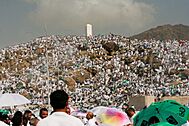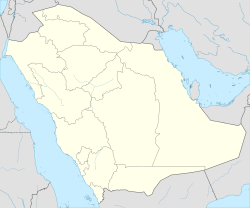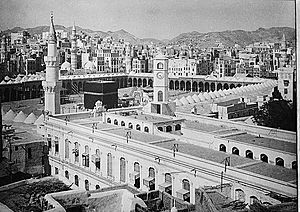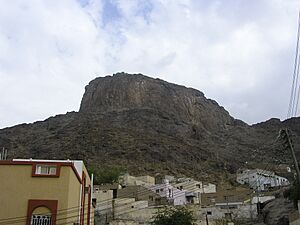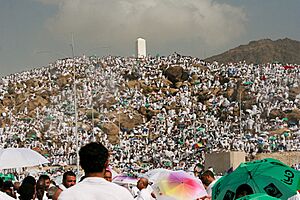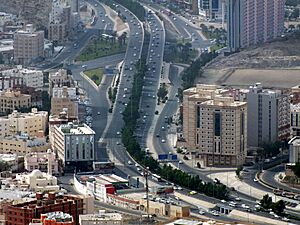Mecca facts for kids
Quick facts for kids
Mecca
مكة
|
|
|---|---|
|
City
|
|
| Makkah al-Mukarramah (مكة المكرمة) | |
|
|
|
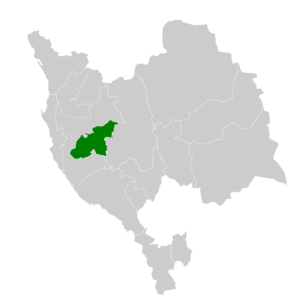
Mecca governorate (green) within
Mecca province |
|
| Country | |
| Province | Mecca Province |
| Governorate | Holy Capital Governorate |
| Established | c. 18th century BCE |
| Founded by | Ibrāhīm and Ismāʿīl (building The Kaaba) |
| Area | |
| • City | 1,200 km2 (500 sq mi) |
| • Land | 760 km2 (290 sq mi) |
| Elevation | 277 m (909 ft) |
| Population
(2022 census)
|
|
| • City | 2,385,509 |
| • Rank | 3rd in Saudi Arabia |
| • Density | 1,990/km2 (5,150/sq mi) |
| • Metro | 2,427,924 (Mecca Governorate) |
| Demonym(s) | Makki (مكي) |
| Time zone | UTC+3 (AST) |
| Area code(s) | +966-12 |
Mecca (officially Makkah al-Mukarramah) is a very important city in western Saudi Arabia. It is considered the holiest city in the religion of Islam. Mecca is about 70 kilometers (44 miles) inland from Jeddah, a city on the Red Sea. It sits in a narrow valley, 277 meters (909 feet) above sea level.
In 2022, about 2.4 million people lived in Mecca. This makes it the third-largest city in Saudi Arabia. Each year, millions of pilgrims visit Mecca for the Hajj pilgrimage. This happens in the twelfth month of the Islamic calendar. Mecca was one of the most visited cities in the world in 2023.
Muslims believe Mecca is where the Islamic prophet Muhammad was born. The Hira cave is just outside the city. Muslims believe the Quran was first revealed to Muhammad there. Visiting Mecca for the Hajj is a duty for all Muslims who are able. The Great Mosque of Mecca, called the Masjid al-Haram, holds the Ka'bah. Muslims believe Abraham and Ishmael built the Ka'bah. It is Islam's holiest site and the direction Muslims face when they pray.
Mecca has grown a lot over time. New, modern buildings like the Abraj Al Bait towers now stand over the Great Mosque. The Saudi government manages the city. The mayor is called the Amin in Arabic.
Contents
What's in a Name?
Mecca has been called by many names. Its exact origin is not fully known. Many people think Mecca is another name for Makkah. Some scholars use it for the holy area around the Ka'bah.
Bakkah
The Quran calls the city Bakkah in one verse. It says, "Indeed the first House [of worship], established for mankind was that at Bakkah." This was likely the city's name during the time of Ibrahim. It was a name for the city long ago.
Makkah and Mecca
Makkah is the official spelling used by the Saudi government. It sounds more like the Arabic word. The full official name is Makkah al-Mukarramah, meaning "Makkah the Honored". The Quran also uses the name Makkah.
The English word Mecca is sometimes used to mean any place that attracts many people. Because of this, some Muslims find it disrespectful when used for the city. Still, Mecca is the common English name for the city.
Other Names for Mecca
Another name for Mecca in the Quran is Umm al-Qurā. This means "Mother of all Settlements". The city has also been called Tihāmah historically. Some believe Fārān, mentioned in the Old Testament, refers to Mecca.
A Look Back in Time
Mecca's early history is not fully clear. There are not many old writings or archaeological finds from the area. The region around Mecca, called Hejaz, was rocky and remote. It only had small towns in oases.
Some researchers believe Mecca had about 10,000 people when Muhammad lived there. This number comes from old records about battles and people moving away.
The first clear mention of Mecca in non-Islamic writings was in 741 CE. However, it was mistakenly placed in a different region.
Islamic Stories of Mecca's Beginnings
In Islamic belief, Mecca's story starts with Biblical figures like Adam, Abraham, Hagar, and Ishmael. Muslims believe Adam built the first house of God in Mecca. This building was destroyed in the Noahic Flood.
Later, Ibrahim (Abraham) left his son Ismāʿīl (Ishmael) and wife Hājar (Hagar) in the valley. People from the Jurhum tribe settled with them. Isma'il and his father are believed to have rebuilt the Ka'bah. This made the area very important.
Under the Quraish Tribe
Around the 5th century, the Quraish tribe took control of Mecca. They became skilled merchants. The Ka'bah was a place where pagan tribes worshipped their gods. The main pagan god was Hubal.
In the 6th century, the Quraish joined the profitable spice trade. Trade routes were shifting from dangerous sea paths to safer land routes. Mecca became a key trading center.
The Arabian Peninsula was often in conflict. But once a year, tribes would agree to a truce. They would gather in Mecca for a pilgrimage. This journey was for religious reasons, to honor their shrine, and drink from the Zamzam Well. It was also a time to settle disagreements and trade goods. These events gave the tribes a shared identity and made Mecca very important.
The Year of the Elephant (Around 570 CE)
This year is famous in Islamic history. It was around 570 CE. According to Islamic sources, a leader named Abraha came to Mecca with a large army and elephants. He wanted to destroy the Ka'bah. He had built a church in another city and wanted people to visit it instead of the Ka'bah.
Islamic tradition says this was the year Muhammad was born. The people of Mecca, led by Abdul Muttalib, tried to protect the Ka'bah. They went to the hills for safety. When Abraha's army attacked, the lead elephant refused to enter Mecca. The Quran says that Allah sent small birds with tiny stones. These birds threw the stones at Abraha's army, defeating them.
Muhammad and the Conquest of Mecca
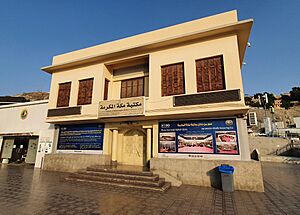
Muhammad was born in Mecca in 570 CE. Islam has been connected to the city ever since. In a nearby cave on Jabal al-Nour, Muhammad began receiving messages from God in 610 CE. He taught about one God, which was different from the pagan beliefs in Mecca.
After facing difficulties for 13 years, Muhammad and his followers moved to Yathrib (later called Medina) in 622 CE. This move is known as the hijrah. The people of Mecca tried to stop Islam, but they failed.
In 628 CE, Muhammad and his followers wanted to visit Mecca for pilgrimage. They made a peace agreement, the Treaty of Hudaybiyyah. This treaty allowed Muslims to enter the city the next year. Two years later, the treaty was broken. Muhammad and 10,000 followers marched into Mecca and took control of the city. They removed the pagan idols. Mecca was declared the holiest site in Islam. It became the center for the Muslim pilgrimage, the Hajj.
Muhammad then returned to Medina. His actions helped unite the Arabian Peninsula under Islam. After Muhammad's death in 632 CE, Islam spread widely. Mecca continued to attract pilgrims from all over the world for the annual Hajj.
Medieval and Later Times
Mecca was never the capital of the early Islamic states. However, Muslim rulers helped maintain the city. They built structures to protect the Ka'bah area from floods.
Mecca was attacked and looted by a group called the Qarmatians in 930 CE. The Black Death also reached Mecca in 1349 CE.
In 1517, the local ruler of Mecca accepted the power of the Ottoman Caliphate. But he kept a lot of local control. In 1803, the city was captured by the First Saudi State. They held Mecca until 1813. The Ottomans then regained control.
In 1853, Sir Richard Francis Burton, a non-Muslim European, visited Mecca disguised as a Muslim. Mecca often faced cholera outbreaks. Between 1830 and 1930, there were 27 outbreaks among pilgrims.
Modern History of Mecca
During World War I, the local ruler, Hussein bin Ali, Sharif of Mecca, revolted against the Ottoman Empire. Mecca was the first city his forces captured in 1916. Hussein declared a new state, the Kingdom of Hejaz, with Mecca as its capital.
In 1924, the Saudi family took control of Mecca. Under Saudi rule, many old buildings in Mecca have been taken down. This was done to expand the city and build new facilities for pilgrims. The city has grown to include areas that were once separate towns.
Mecca does not have its own airport. People fly to King Abdulaziz International Airport in Jeddah (about 70 km away) or Ta'if Regional Airport (about 120 km away).
The city is connected by major highways. Highway 40 links it to Jeddah in the west and Riyadh in the east. Highway 15 connects it to Medina in the north and other cities in the south.
In 2018, a new high-speed train, the Haramain high-speed railway, started running. It connects Mecca and Medina, stopping in Jeddah. The trains can go up to 300 km/h (190 mph). This makes travel between the holy cities much faster.
Non-Muslims are not allowed to enter certain holy areas of Mecca under Saudi law.
Grand Mosque Seizure in 1979
On November 20, 1979, a group of armed people took over the Grand Mosque. They claimed the Saudi royal family was not following pure Islam. They held thousands of pilgrims hostage. The siege lasted two weeks. It resulted in many deaths and damage to the mosque. Since then, the Grand Mosque has been expanded many times.
Changes to Historic Sites
Under Saudi rule, it is estimated that about 95% of Mecca's historic buildings have been taken down since 1985. Many of these buildings were over a thousand years old. This includes the house of Khadijah, Muhammad's wife, and his birthplace. These demolitions were mainly to build hotels, apartments, and other facilities for the increasing number of Hajj pilgrims.
Why Mecca is Important in Islam
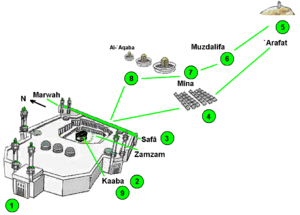
Mecca is very important in Islam. It is considered the holiest city for all Muslims. Its importance comes from its role in the Hajj and Umrah pilgrimages. It is also important because it is the birthplace of Muhammad.
Masjid al-Haram (The Great Mosque)
The Masjid al-Haram is where two key parts of the Hajj and Umrah take place. These are walking around the Ka'bah (called tawaf) and walking between the two hills of Safa and Marwa (called sa'ee). The mosque also has the Zamzam Well. Muslims believe that praying in this mosque is like praying 100,000 times in any other mosque.
The Kaaba
There are different beliefs about who first built the Ka'bah. Some believe angels built it, while others say Adam did. It has been rebuilt many times. The Ka'bah is the direction Muslims face when they pray. The area around the Ka'bah where Muslims walk is called the Mataf.
The Black Stone (Hajr-e-Aswad)
The Black Stone is a special stone. Scientists think it might be a meteorite. Muslims believe it came from Paradise. It is placed in the eastern corner of the Ka'bah. It is a tradition to touch and kiss the stone. This area is usually very crowded.
Maqam Ibrahim
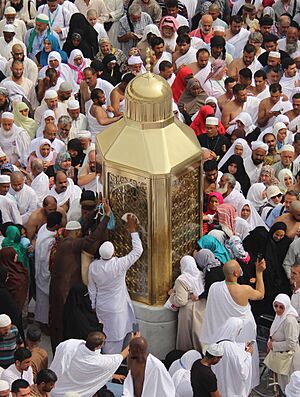
This is a stone where Ibrahim (Abraham) stood to build the higher parts of the Ka'bah. It has two footprints that are larger than average human feet. The stone is kept in a golden chamber next to the Ka'bah.
Safa and Marwa
Muslims believe the mountains of Safa and Marwa are symbols of God. Walking between these two mountains seven times is a required part of the Umrah pilgrimage.
Hajj and 'Umrah Pilgrimages
The Hajj pilgrimage, also called the greater pilgrimage, brings millions of Muslims to Mecca. It almost triples the city's population for one week each year. In 2019, over 2.4 million pilgrims came for Hajj. The Umrah, or lesser pilgrimage, can be done at any time of the year.
Every adult Muslim who is healthy and can afford it must perform the Hajj at least once. The Umrah is not required, but it is recommended. Besides the Masjid al-Haram, pilgrims also visit nearby towns like Mina, Muzdalifah, and Mount Arafat for Hajj rituals.
Jabal an-Nur (Mountain of Light)
This mountain is where Muslims believe Muhammad spent time alone, away from the busy city. It is on the eastern side of Mecca and is the highest point in the city, at 642 meters (2,106 feet).
Hira'a Cave
This cave is on top of Jabal an-Nur. Muslims believe it is where Muhammad received his first message from God through the archangel Gabriel when he was 40 years old.
Mecca's Location and Features

Mecca is in the Hejaz region. This region is a strip of mountains about 200 km (124 miles) wide. It separates the Nafud desert from the Red Sea. The city is in a valley, about 70 km (44 miles) east of Jeddah. Mecca is 277 meters (909 feet) above sea level. The city has 34 districts.
The city's center is around the al-Haram area, which includes the Masjid al-Haram. The old city is around the mosque. The main street leading to al-Haram is Ibrahim al-Khalil Street, named after Ibrahim. You can still see traditional homes made of local rock in the central area, next to modern hotels. The total area of modern Mecca is over 1,200 square kilometers (463 square miles).
Climate in Mecca
Mecca has a hot desert climate. Even in winter, temperatures are warm to hot, from 19°C (66°F) at night to 30°C (86°F) in the afternoon. Summer temperatures are very hot, often above 40°C (104°F) in the afternoon. It usually rains a little between November and January. Heavy thunderstorms can also happen in winter.
| Climate data for Mecca (1991-2020) | |||||||||||||
|---|---|---|---|---|---|---|---|---|---|---|---|---|---|
| Month | Jan | Feb | Mar | Apr | May | Jun | Jul | Aug | Sep | Oct | Nov | Dec | Year |
| Record high °C (°F) | 39.0 (102.2) |
40.0 (104.0) |
42.4 (108.3) |
44.7 (112.5) |
49.4 (120.9) |
51.8 (125.2) |
51.0 (123.8) |
50.0 (122.0) |
49.8 (121.6) |
47.0 (116.6) |
41.2 (106.2) |
39.4 (102.9) |
51.8 (125.2) |
| Mean daily maximum °C (°F) | 30.9 (87.6) |
32.6 (90.7) |
35.4 (95.7) |
39.0 (102.2) |
42.4 (108.3) |
43.9 (111.0) |
43.2 (109.8) |
42.9 (109.2) |
42.9 (109.2) |
40.4 (104.7) |
35.6 (96.1) |
32.5 (90.5) |
38.5 (101.3) |
| Daily mean °C (°F) | 24.3 (75.7) |
25.4 (77.7) |
27.8 (82.0) |
31.3 (88.3) |
34.6 (94.3) |
36.2 (97.2) |
36.2 (97.2) |
35.9 (96.6) |
35.2 (95.4) |
32.5 (90.5) |
28.7 (83.7) |
25.9 (78.6) |
31.2 (88.1) |
| Mean daily minimum °C (°F) | 19.2 (66.6) |
19.9 (67.8) |
21.8 (71.2) |
25.1 (77.2) |
28.1 (82.6) |
29.3 (84.7) |
29.8 (85.6) |
30.1 (86.2) |
29.2 (84.6) |
26.5 (79.7) |
23.4 (74.1) |
20.7 (69.3) |
25.3 (77.5) |
| Record low °C (°F) | 11.0 (51.8) |
10.0 (50.0) |
13.0 (55.4) |
15.6 (60.1) |
20.3 (68.5) |
22.0 (71.6) |
23.4 (74.1) |
23.4 (74.1) |
22.0 (71.6) |
18.0 (64.4) |
16.4 (61.5) |
12.4 (54.3) |
10.0 (50.0) |
| Average precipitation mm (inches) | 20.7 (0.81) |
2.5 (0.10) |
5.2 (0.20) |
8.3 (0.33) |
2.6 (0.10) |
0.0 (0.0) |
1.4 (0.06) |
5.8 (0.23) |
6.3 (0.25) |
14.1 (0.56) |
23.2 (0.91) |
24.7 (0.97) |
104.6 (4.12) |
| Average precipitation days (≥ 1.0 mm) | 1.8 | 0.3 | 0.6 | 0.7 | 0.3 | 0.0 | 0.1 | 0.8 | 0.7 | 1.1 | 1.7 | 1.3 | 9.6 |
| Average relative humidity (%) (daily average) | 58 | 54 | 48 | 43 | 36 | 33 | 34 | 39 | 45 | 50 | 58 | 59 | 46 |
| Mean monthly sunshine hours | 260.4 | 245.8 | 282.1 | 282.0 | 303.8 | 321.0 | 313.1 | 297.6 | 282.0 | 300.7 | 264.0 | 248.0 | 3,400.5 |
| Mean daily sunshine hours | 8.4 | 8.7 | 9.1 | 9.4 | 9.8 | 10.7 | 10.1 | 9.6 | 9.4 | 9.7 | 8.8 | 8.0 | 9.3 |
| Source 1: World Meteorological Organization, Jeddah Regional Climate Center | |||||||||||||
| Source 2: Deutscher Wetterdienst (sunshine hours, 1986–2000) | |||||||||||||
Mecca's Economy
Mecca's economy relies heavily on the pilgrims who come for Umrah and Hajj. The money from pilgrims helps not only Mecca but also the economy of the whole Arabian Peninsula.
Pilgrims bring money in several ways. One way is through services provided to them. For example, the Saudi airline, Saudia, gets a lot of its income from the pilgrimage. Hotels and lodging companies also earn money from housing pilgrims. The city earns over $100 million from the Hajj.
Mecca also has some industries, like textiles and furniture. But it is not a major part of Saudi Arabia's economy, which is mostly about oil. Most of Mecca's economy is based on services.

The city has grown a lot because more people can travel by plane. Thousands of Saudis work all year to help with the Hajj. This has led to more demand for housing and services. Mecca now has freeways, shopping malls, and tall buildings.
Education and Healthcare
Education in Mecca started to develop in the late Ottoman period. The first major school, Madrasat al-Falāḥ, was founded in 1911–12.
Mecca has many public and private schools for boys and girls. Arabic is the main language of teaching, with English as a second language. For higher education, Mecca has one university, Umm Al-Qura University. It started as a college in 1949 and became a public university in 1981.
The Saudi government provides free healthcare to all pilgrims. Mecca has ten main hospitals and many clinics. Temporary clinics are also set up during the Hajj to help pilgrims.
People of Mecca

Mecca is a very crowded city. Most long-term residents live in the Old City, near the Great Mosque. Many of them work in the Hajj industry, helping pilgrims.
Millions of Muslims visit Mecca each year for Hajj and Umrah. These pilgrims come from many different countries and backgrounds. Many have stayed and become residents of the city. Because of this, Mecca is a very diverse city.
Non-Muslims are generally not allowed to enter Mecca under Saudi law. However, some non-Muslims have visited the city in the past.
Culture and Sports
Mecca's culture is greatly influenced by the many pilgrims who visit every year. This makes it a very diverse city in the Muslim world.
Al Baik, a local fast-food chain, is very popular with both pilgrims and locals.
In the past, common sports in Mecca were wrestling and foot races. Today, football is the most popular sport. Mecca has some of Saudi Arabia's oldest sports clubs, like Al Wahda FC. The King Abdul Aziz Stadium is the largest stadium in Mecca.
Famous Buildings
The Abraj al-Bait Complex stands next to the Masjid al-Haram. It is a group of seven buildings. The central clock tower is 601 meters (1,972 feet) tall, making it one of the world's tallest buildings. The whole complex is also one of the largest buildings by floor area.
The Mecca Gate, also known as the Quran Gate, is at the western entrance of the city. It marks the boundary where non-Muslims are not allowed to enter. The gate was designed in 1979. It looks like a book, representing the Quran, sitting on a bookrest.
Getting Around Mecca
Air Travel
Mecca does not have an active airport within the city. Travelers usually fly into King Abdulaziz International Airport in Jeddah or Ta'if Regional Airport. Jeddah Airport has a special Hajj Terminal for pilgrims.
Roads
Mecca is connected by two important highways. Highway 40 links it to Jeddah in the west and Riyadh in the east. Highway 15 connects Mecca to Medina in the north and other cities in the south. Mecca has four ring roads, which can be very busy. The city also has many tunnels.
Metro and Rail
Al Masha'er Al Muqaddassah Metro This metro line opened in 2010. It is 18.1 kilometers (11.2 miles) long. It takes pilgrims to the holy sites of Arafat, Muzdalifah, and Mina. This helps reduce road traffic during the Hajj season. It only runs during Hajj.
Mecca Metro The Mecca Metro is a planned metro system for the city. It will have four lines and will be in addition to the existing Hajj metro.
High-Speed Rail In 2018, the Haramain high-speed railway started operating. It connects Mecca and Medina through Jeddah. The trains can travel up to 300 km/h (190 mph). This reduces travel time between the two cities to less than two hours.
See also
 In Spanish: La Meca para niños
In Spanish: La Meca para niños




